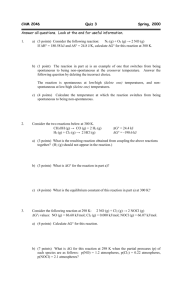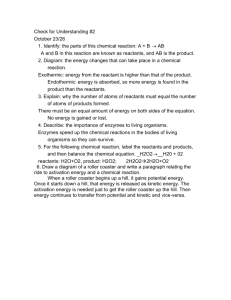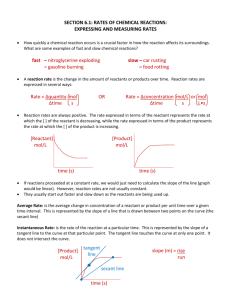Chemical Kinetics
advertisement
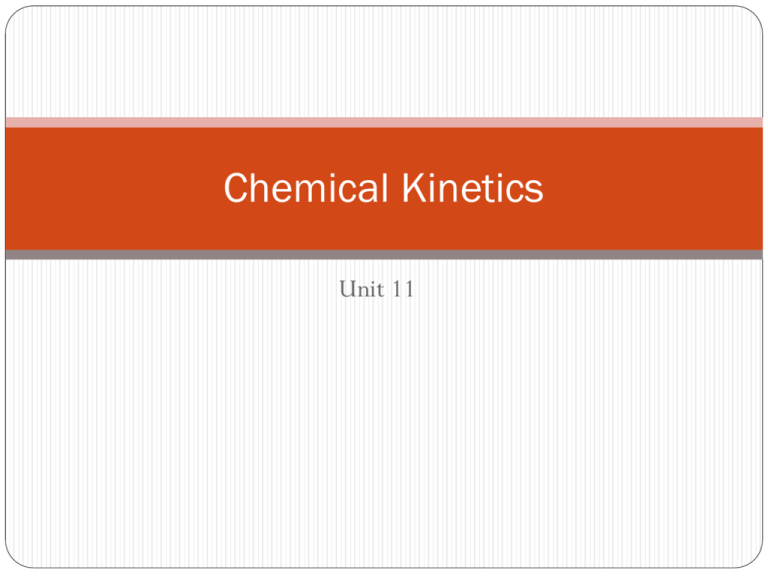
Chemical Kinetics Unit 11 Overview Factors affecting reactions Collision Model Activation energy, activated complex Exothermic/endothermic reactions Energy of reactions ∆E Reaction Rate Average reaction rate Instantaneous reaction rate Kinetics Stoichiometry Reaction Rate and Concentration (Differential) Rate laws Specific rate constant (k) Writing rate laws Reaction Order Rate laws Integrated Rate Laws Graphing Solving (0, 1st, 2nd order) Half life equations Rate Constant and Temperature Arrhenius equation Catalysis Homogeneous, heterogeneous, enzymes Reaction Mechanisms Identifying intermediates Rate determining step Chemical Kinetics Thermochemistry = does a reaction take place? Kinetics = how fast does the reaction happen? Kinetics: The area of chemistry concerned with the speeds (rates) of reactions Factors Affecting Reaction Rates Physical state of reactants (surface area) Concentration of reactants Temperature at which reaction occurs Presence of a catalyst Pressure of gaseous reactants or products Collision Model Molecules must collide to react Only a small fraction of collisions produces a reaction. Why? Collision Model Collisions must have enough energy to produce the reaction (must equal or exceed the activation energy). Reactants must have proper orientation to allow the formation of new bonds. Collision Model Activation Energy Activation Energy (Ea)– minimum energy required to transform reactants into the activated complex (The minimum energy required to produce an effective collision) Example: flame, spark, high temperature, radiation The lower the Ea, the faster the reaction Activation Energy Activated Complex – transitional structure All bonds have been broken but no new bonds have formed Point in reaction of highest energy but lowest stability Exothermic Processes Processes in which energy is released as it proceeds, and surroundings become warmer Reactants Products + energy Endothermic Processes Processes in which energy is absorbed as it proceeds, and surroundings become colder Reactants + energy Products Energy of Reactions (∆E) Same as ∆H “Heat” and “energy” can be used interchangeably ∆E = ∆Eproducts- ∆Ereactants - ∆E = exothermic (energy lost) +∆E = endothermic (energy gained) Reaction Rate Reaction Rate: the change in concentration of reactants per unit time as a reaction proceeds (M/s) A B D[A] rate = Dt D[A] = change in concentration of A over time period Dt D[B] rate = Dt D[B] = change in concentration of B over time period Dt Because [A] decreases with time, D[A] is negative. A B time D[A] rate = Dt rate = D[B] Dt 13.1 Reaction Rate Average reaction rate: average rate throughout the course of the reaction Instantaneous reaction rate: rate of reaction at a specific point in time during the reaction Think of a car trip where you drove 100 miles in 2 hours Average speed = 50 mi/hr Instantaneous speed is speed at specific point – you don’t go exactly 50 mi/hr the entire trip Br2 (aq) + HCOOH (aq) 2Br- (aq) + 2H+ (aq) + CO2 (g) slope of tangent D[Br2] average rate = Dt =- slope of tangent slope of tangent [Br2]final – [Br2]initial tfinal - tinitial instantaneous rate = rate for specific instance in time (slope of tangent) Kinetics Stoichiometry When mole ratios are not 1:1, stoichiometry is used to compare rates of reactions aA + bB cC + dD 1 ∆[A] 1 ∆[B] Rate = - a ∆t = - b ∆t = 1 ∆[C] 1 ∆[D] c ∆t = d ∆t Kinetics Stoichiometry 2HI H2 + I2 If the rate at which H2 appears, ∆[H2]/∆t, is 6.0×10-5 M/s at a particular instant, at what rate is HI disappearing at this same time, - ∆[HI]/∆t? 1 ∆[HI] Rate = = 2 ∆t Therefore, - 1 ∆[H2] 1 ∆t 1 1 ∆[HI] = 1 (6.0×10-5 M/s ) 2 ∆t - ∆[HI] = 1.2×10-4 M/s ∆t Reaction Rate and Concentration The initial rate of a reaction depends on the concentration of the reactants Rate changes based on the concentration of reactants (Differential) Rate Law: an equation that relates reaction rate and concentrations of reactants Rate a [reactants] a means “proportional to” Rate Law R = k[A]n[B]m R = reaction rate k = specific rate constant [A] and [B] = concentrations of reactants n and m = the order of the reactant (usually 0, 1, 2) (not related to moles of reactants from the equation) Overall order of reaction = n + m Rate Laws Rate laws are always determined experimentally. Reaction order is always defined in terms of reactant (not product) concentrations. The order of a reactant is not related to the stoichiometric coefficient of the reactant in the balanced chemical equation. F2 (g) + 2ClO2 (g) 2FClO2 (g) rate = k [F2][ClO2]1 13.2 Specific Rate Constant (k) 1. 2. 3. 4. 5. 6. Once the reaction orders are known, the value of k must be determined from experimental data Value of k is for a specific reaction; k has a different value for other reactions, even at the same conditions Units of k depend on the overall order of the reaction Value of k does not change for different concentrations of reactants or products Value of k is for reaction at a specific temperature; if temperature increases, k increases Value of k changes if a catalyst is present Writing a (differential) Rate Law Problem -Write the rate law, determine the value of the rate constant, k, and the overall order for the following reaction: 2 NO(g) + Cl2(g) 2 NOCl(g) Experiment [NO] (mol/L) [Cl2] (mol/L) Rate Mol/L·s 1 0.250 0.250 1.43 x 10-6 2 0.500 0.250 5.72 x 10-6 3 0.250 0.500 2.86 x 10-6 4 0.500 0.500 11.4 x 10-6 Writing a Rate Law Step 1 – Determine the values for the exponents in the rate law: R = k[NO]n[Cl2]m Experiment [NO] (mol/L) [Cl2] (mol/L) Rate Mol/L·s 1 0.250 0.250 1.43 x 10-6 2 0.500 0.250 5.72 x 10-6 3 0.250 0.500 2.86 x 10-6 4 0.500 0.500 1.14 x 10-5 In experiment 1 and 2, [Cl2] is constant while [NO] doubles. The rate quadruples, so the reaction is second order with respect to [NO] R = k[NO]2[Cl2]m Writing a Rate Law R = k[NO]2[Cl2]m Experiment [NO] (mol/L) [Cl2] (mol/L) Rate Mol/L·s 1 0.250 0.250 1.43 x 10-6 2 0.500 0.250 5.72 x 10-6 3 0.250 0.500 2.86 x 10-6 4 0.500 0.500 1.14 x 10-5 In experiment 2 and 4, [NO] is constant while [Cl2] doubles. The rate doubles, so the reaction is first order with respect to [Cl2] R = k[NO]2[Cl2] Writing a Rate Law Part 2 – Determine the value for k, the rate constant, by using any set of experimental data: R = k[NO]2[Cl2] Experiment 1 [NO] (mol/L) [Cl2] (mol/L) Rate Mol/L·s 0.250 0.250 1.43 x 10-6 2 mol mol mol 1.43 x 10 k 0.250 0.250 Ls L L 6 2 1.43 x106 mol L3 L 5 k 9.15 x 10 3 3 2 0.250 L s mol mol s Reaction Order Given the rate law R = k[NO]2[Cl2] We say that the reaction is 2nd order with respect to NO 1st order with respect to Cl2 Overall the order of the reaction is a 3rd order reaction 2+1=3 Example 2 Run # Initial [A] ([A]0) Initial [B] ([B]0) Initial Rate (v0) 1 1.00 M 1.00 M 1.25 x 10-2 M/s 2 1.00 M 2.00 M 2.5 x 10-2 M/s 3 2.00 M 2.00 M 2.5 x 10-2 M/s What is the order with respect to A? 0 What is the order with respect to B? 1 What is the overall order of the reaction? 1 Example 3 [NO(g)] (mol dm-3) [Cl2(g)] (mol dm-3) Initial Rate (mol dm-3 s-1) 0.250 0.250 1.43 x 10-6 0.250 0.500 2.86 x 10-6 0.500 0.500 1.14 x 10-5 What is the order with respect to Cl2? 1 What is the order with respect to NO? 2 What is the overall order of the reaction? 3 Reaction Order Zero Order Rate Law R = k 1st Order 2nd Order 3rd Order R = k[A]3 R = k[A][B] R = k[A] R = k[A][B][C] 2 R = k[A] R = k[A] 2[B] Concentration VS Time Integrated Rate Law Graph data to solve for order of reaction Zero Order = time vs concentration is linear 1st Order = time vs ln[concentration] is linear 2nd 1 Order = time vs concentration is linear Zero Order Reactions 13.3 First Order Reactions 13.3 Second Order Reactions Solving an Integrated Rate Law Time (s) [H2O2] (mol/L) 0 1.00 120 0.91 300 0.78 600 0.59 1200 0.37 1800 0.22 2400 0.13 3000 0.082 3600 0.050 Problem: Find the integrated rate law and the value for the rate constant, k Time vs. [H2O2] Time [H2O2] Regression results: y = ax + b a = -2.64 x 10-4 b = 0.841 r2 = 0.8891 r = -0.9429 Time (s) [H2O2] 0 1.00 120 0.91 300 0.78 600 0.59 1200 0.37 1800 0.22 2400 0.13 3000 0.082 3600 0.050 Time vs. ln[H2O2] ln[H2O2] Time (s) ln[H2O2] 0 0 120 -0.0943 300 -0.2485 600 -0.5276 1200 -0.9943 1800 -1.514 Regression results: 2400 -2.04 y = ax + b a = -8.35 x 10-4 b = -.005 r2 = 0.99978 r = -0.9999 3000 -2.501 3600 -2.996 Time Time vs. 1/[H2O2] Time 1/[H2O2] Regression results: y = ax + b a = 0.00460 b = -0.847 r2 = 0.8723 r = 0.9340 Time (s) 1/[H2O2] 0 1.00 120 1.0989 300 1.2821 600 1.6949 1200 2.7027 1800 4.5455 2400 7.6923 3000 12.195 3600 20.000 Integrated Rate Law The graph is linear for “time vs ln[H2O2]” The reaction is 1st order VS VS Concentration VS Time Rate laws for concentration of reactants versus time are based on the linear equation y = ax + b Zero Order Reactions (time vs concentration) [A] = -kt + [A]0 1st Order (time vs ln[concentration]) ln[A] = -kt + ln[A]0 2nd Order (time vs 1/concentration) 1 1 kt [ A] [ A]0 The reaction 2A B is first order in A with a rate constant of 2.8 x 10-2 s-1 at 800C. How long will it take for A to decrease from 0.88 M to 0.14 M ? ln[A] = -kt + ln[A]0 ln[A] - ln[A]0 = - kt [A]0 = 0.88 M [A] = 0.14 M ln[A]0 - ln[A] = kt ln[A]0 – ln[A] t= k ln = [A]0 [A] k ln = 0.88 M 0.14 M 2.8 x 10-2 s-1 = 66 s Half-life t½ Time it takes for concentration of reactant to equal ½ of its initial value A fast reaction will have a short half-life In a first order reaction, concentration of reactant decreases by ½ each time interval of t½ [A] = ½ [A]0 Half-life t½ For zero and second order reactions, half-life changes based on concentration of the reactant To find equation for half-life, place ½[A] 0 in for [A] in each integrated rate law and put t½ in for t When [A] = ½[A]0 and t = t½ … Zero Order: [A] = -kt + [A]0 [ A]0 t1/ 2 2k 1st Order ln[A] = -kt + ln[A]0 0.693 t1/ 2 k 2nd 1 1 kt [ A] [ A]0 1 t1/ 2 k [ A]0 Order Half-life t½ What is the half-life of N2O5 if it decomposes with a rate constant of 5.7 x 10-4 s-1? t½ = 0.693 = 1200 s = 20 minutes -4 -1 5.7 x 10 s How do you know decomposition is first order? units of k are (s-1) SUMMARY Order Rate Law Concentration-Time Equation 0 rate = k [A] - [A]0 = - kt 1 rate = k [A] ln[A] - ln[A]0 = - kt 2 [A]2 rate = k 1 1 = kt [A] [A]0 Half-Life [A]0 2k Ln 2 t½ = k 1 t½ = k[A]0 t½ = Rate Constant and Temperature Reaction rate increases with temperature Molecules move faster More molecules collide to cause a reaction in a time period Molecules have greater kinetic energy at higher temperatures More molecules will have enough energy to reach the activation energy of the reaction at higher temperatures Boltzmann Distribution Curve Rate Constant and Temperature At higher temperatures (T2), more molecules are able to reach the activation energy Rate Constant and Temperature Arrhenius Equation: relationship between k and T Ea is the activation energy (J/mol) -Ea 1 Ln k = + lnA R T R is the gas constant (8.314 J/K•mol) T is the absolute temperature (K) A is the frequency factor Takes into account collision frequency and orientation Graphing Arrhenius A plot of lnk versus 1 / T produces a straight line with the familiar form y = - mx + b, where x = 1 /T y = lnk m=-Ea/R b = lnA The activation energy E a can be determined from the slope m of this line: E a = - m · R Catalysis Catalyst: A substance that speeds up a reaction by lowering activation energy Homogeneous catalyst: Present in the same phase as the reacting molecules. Heterogeneous catalyst: Present in a different phase than the reacting molecules. Enzyme: A large molecule (usually a protein) that catalyzes biological reactions. Avoids temperature increase in reactions of living organisms A catalyst is a substance that increases the rate of a chemical reaction without itself being consumed. Ea uncatalyzed k catalyzed ratecatalyzed > rateuncatalyzed 13.6 Endothermic Reaction w/Catalyst Exothermic Reaction w/Catalyst Factors Affecting Reaction Rates Physical state of reactants (surface area) Increased surface area means more collisions between reacting molecules Concentration of reactants Higher concentration means more molecules (solute) to react meaning more collisions Temperature at which reaction occurs Higher kinetic energy Molecules moving faster so collide more frequently Presence of a catalyst Speeds up a reaction without being used up Lowers activation energy Pressure of gaseous reactants or products Increased number of collisions Rate Laws (vocabulary) Elementary Reaction – rate law is based directly on proportionality Describes an individual molecular event Unimolecular – overall rate law is 1st order Rate = k[A] Bimolecular – overall rate law is 2nd order Rate = k[A]2 Rate = k[A][B] Termolecular – overall rate law is 3rd order Rate = k[A]3 Rate = k[A] 2[B] Rate = k[A][B][C] Reaction Mechanisms Some reactions occur in one step, others do not Reaction Mechanism: step-by-step sequence of reactions by which the overall chemical change occurs A chemical equation does not tell us how reactants become products; it is a summary of the overall process. The sum of the elementary steps must give the overall balanced equation for the reaction Reactants Products The sign has represents the reaction mechanism, but gives no indication of the steps in the mechanism Reaction Mechanisms (Example) For the reaction: 2NO (g) + O2 (g) 2NO2 (g) The following steps occur: Elementary Step 1: NO + NO N2O2 + Elementary Step 2: N2O2 + O2 2NO2 Overall reaction: 2NO + O2 2NO2 N2O2 is detected during the reaction! Reaction Intermediates Intermediates are species that appear in a reaction mechanism but not in the overall balanced equation. An intermediate is always formed in an early elementary step and consumed in a later elementary step. Elementary step: NO + NO N2O2 + Elementary step: N2O2 + O2 2NO2 Overall reaction: 2NO + O2 2NO2 Energy Diagrams For multi-step reactions, each elementary step requires activation energy and has its own transition state Peaks = transition states Valleys = intermediates Energy Diagrams (multi-step) Writing Reaction Mechanisms • The sum of the elementary steps must give the overall balanced equation for the reaction. • The rate-determining step should predict the same rate law that is determined experimentally. The Rate-Determining Step In a multi-step reaction, the slowest step is the rate-determining step. It therefore determines the rate of reaction. Step 1. NO + Cl2 <----> NOCl2 (fast) Step 2. NOCl2+ NO ----> 2NOCl (slow) Together they give: 2NO + Cl2 ----> 2NOCl Step 2 is the rate determining step Identifying the Rate-Determining Step For the reaction: 2H2(g) + 2NO(g) N2(g) + 2H2O(g) The experimental rate law is: R = k[NO]2[H2] Which step in the reaction mechanism is the rate-determining (slowest) step? Step #1 H2(g) + 2NO(g) N2O(g) + H2O(g) Step #2 N2O(g) + H2(g) N2(g) + H2O(g) Step #1 agrees with the experimental rate law
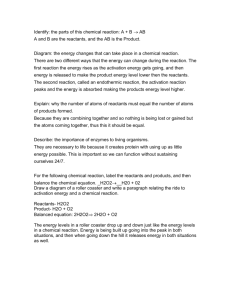

![[SO2]2[O2] [SO3]2 524.4K• 462.9K• 8.314 J mol•K • ln125.4 61.5K](http://s3.studylib.net/store/data/008432217_1-f6f0ddc631a0ec89f84a5e786b3339ef-300x300.png)

